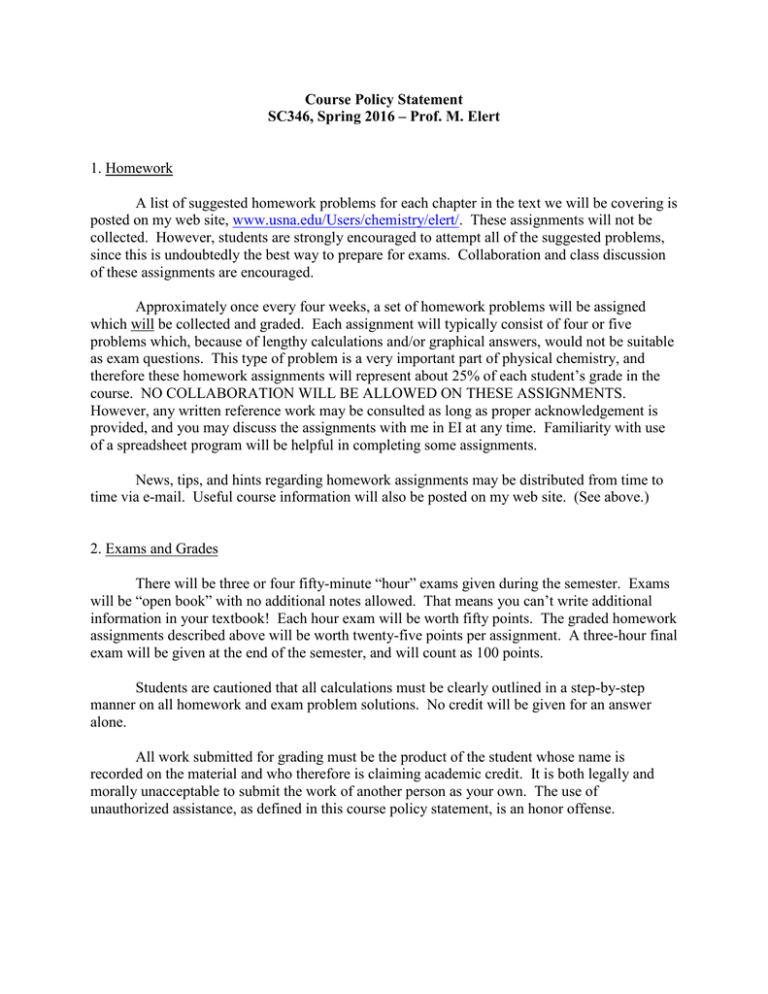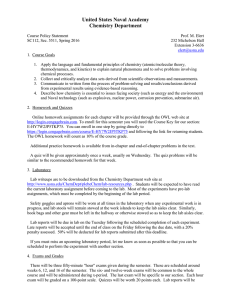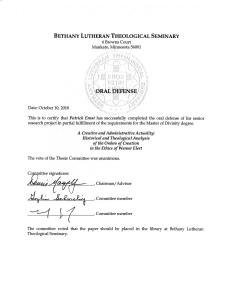Course Policy Statement SC346, Spring 2016 – Prof. M. Elert 1. Homework
advertisement

Course Policy Statement SC346, Spring 2016 – Prof. M. Elert 1. Homework A list of suggested homework problems for each chapter in the text we will be covering is posted on my web site, www.usna.edu/Users/chemistry/elert/. These assignments will not be collected. However, students are strongly encouraged to attempt all of the suggested problems, since this is undoubtedly the best way to prepare for exams. Collaboration and class discussion of these assignments are encouraged. Approximately once every four weeks, a set of homework problems will be assigned which will be collected and graded. Each assignment will typically consist of four or five problems which, because of lengthy calculations and/or graphical answers, would not be suitable as exam questions. This type of problem is a very important part of physical chemistry, and therefore these homework assignments will represent about 25% of each student’s grade in the course. NO COLLABORATION WILL BE ALLOWED ON THESE ASSIGNMENTS. However, any written reference work may be consulted as long as proper acknowledgement is provided, and you may discuss the assignments with me in EI at any time. Familiarity with use of a spreadsheet program will be helpful in completing some assignments. News, tips, and hints regarding homework assignments may be distributed from time to time via e-mail. Useful course information will also be posted on my web site. (See above.) 2. Exams and Grades There will be three or four fifty-minute “hour” exams given during the semester. Exams will be “open book” with no additional notes allowed. That means you can’t write additional information in your textbook! Each hour exam will be worth fifty points. The graded homework assignments described above will be worth twenty-five points per assignment. A three-hour final exam will be given at the end of the semester, and will count as 100 points. Students are cautioned that all calculations must be clearly outlined in a step-by-step manner on all homework and exam problem solutions. No credit will be given for an answer alone. All work submitted for grading must be the product of the student whose name is recorded on the material and who therefore is claiming academic credit. It is both legally and morally unacceptable to submit the work of another person as your own. The use of unauthorized assistance, as defined in this course policy statement, is an honor offense. 3. Course Goals By the end of the course, students will be able to: 1. explain the origins of quantum mechanics 2. explain and solve problems involving translational, vibrational, and rotational motion 3. explain and solve problems involving atomic structure and spectra 4. describe molecular structure in terms of valence bond theory and molecular orbital theory 5. apply group theory to molecular structure and spectra 6. explain and solve problems involving rotational, vibrational, and electronic spectra 7. explain and solve problems involving the Boltzmann distribution and partition functions 8. use partition functions to calculate selected thermodynamic functions M. L. ELERT 232 Michelson Hall 3-6636 elert@usna.edu www.usna.edu/Users/chemistry/elert /



